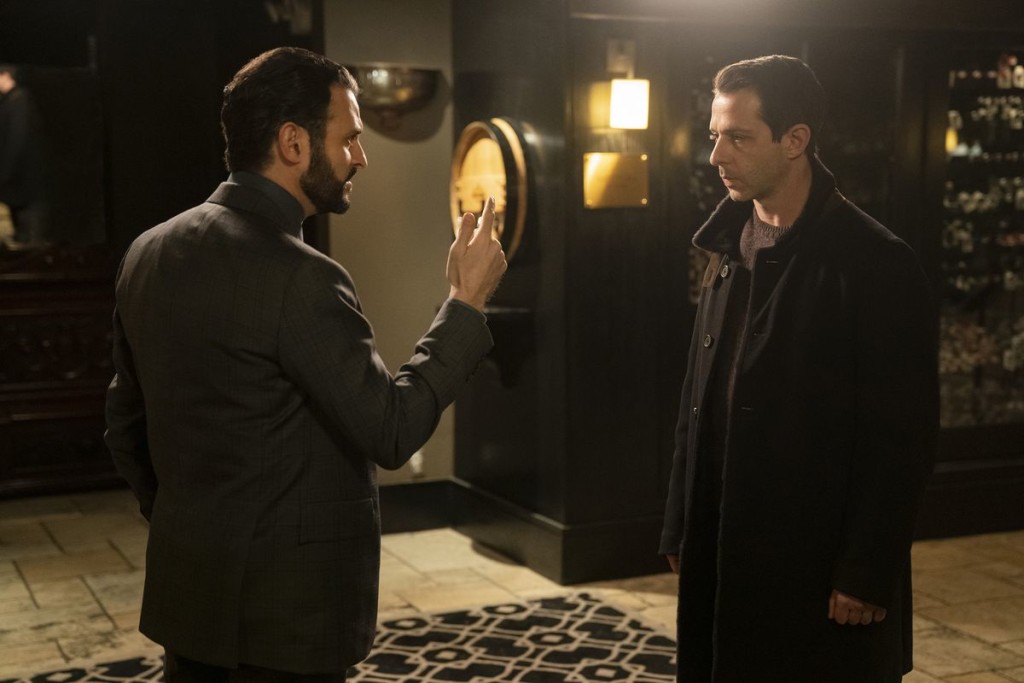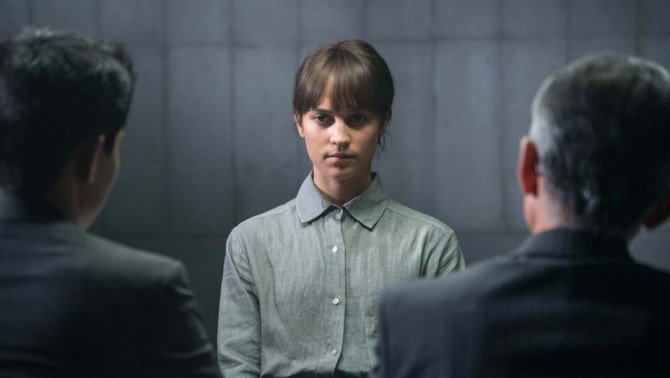It’s a true Mish-Mash Monday as the television/movie landscape has become more diversified than ever. Do you watch The Old Guard on Netflix? Greyhound on Apple TV? Palm Springs on Hulu? My Spy on Amazon?
In the absence of big juicy Hollywood theatrical releases, the B-movie (or second-tier movie) has become the alpha. The problem is, the places where you can watch these movies are so spread out that you don’t know where to find them, or that they even exist.
How confusing is it for someone who watched Tom Hanks dominate the box office for two decades to see his latest film debut on Apple TV? Your initial thought is, “It can’t be that good or else it would’ve been in theaters.” But is that true? Or is the line between theatrical and home movies blurring so much that a home movie can make a bigger splash than a theatrical one?
The answer may come in the form of The Gray Man, the new Russo Brothers project that will star Chris Evans and Ryan Gosling which will have a budget of 200 million dollars. This signifies Netflix’s first true commitment to a theatrical level experience on the small screen. They’ve dabbled. The Irishman and Extraction being two examples. But 200 million is theatrical level money.
The Gray Man is a book series Hollywood’s been trying to put together forever. I remember Adam Cozad wrote a draft that made the Black List back in 2010. I believe that got him some work on a Bond film but that he didn’t get final credit. He later wrote Jack Ryan: Shadow Recruit. And while he had a long stretch of no film credits, he recently wrote the sexily-shot sci-fi flick, Underwater. Maybe I’ll review his draft of Gray Man tomorrow.
The Gray Man appears to be building on the revelation that Netflix’s most popular movies are big splashy action flicks. The Old Guard, Extraction, Triple Frontier, 6 Underground. Who would’ve thought that even on the small screen, action would reign supreme? Why does action reign supreme? Because it’s like the language of love, baby. Everyone in the world understands a car chase.
Hence, if writing an action script has ever tickled your fancy, this is a good time to massage that tickle. All these streamers are global (or thinking global in the future). And since action is global expect Apple and Amazon to copy Netflix’s formula.
The question is, what kind of action script should you write to get Netflix, Amazon, and Apple to take your call?
As we established during Action Showdown and its subsequent winning script, one of the biggest hindrances of the genre is that it’s inherently generic. Extraction is about a guy extracting a kidnapped kid. Triple Frontier is about guys stealing money from drug lords. The Old Guard is about a de facto black ops team that’s immortal (and fights with swords!). Are any of these concepts all that unique?
If the answer is no, which it is, how are they getting made? Well, something to keep in mind is that these movies are being made for a lower barrier to entry. Tenet requires that we plan, drive, park, pay, and watch. The Old Guard requires that we click two buttons. We don’t even have to move our body.
So that takes care of SOME of the reason it’s okay for these ideas to be generic. But not all. Because these projects are still beating out other projects to production. The Russo Brothers of the world are still drawn to these projects over that recent script of yours about a Chicago cop teaming up with the FBI to take out a Ukrainian drug lord. Why?
The only thing I can identify from a story component is that they all have one slightly different angle. Emphasis on the word “slightly.” Extraction was about an extraction in India. We hadn’t seen a big action movie like that set in India before.
Triple Frontier took a similar route. It built its concept around this almost mythical area in South America known as the “Triple Frontier,” which represents more drug dealing per capita than any other place in the world. It was also somewhat of an extraction narrative in that they were extracting money and then had to escape with it. That was kind of unique.
The Old Guard is a black ops movie with a vampire component to it. The group is immortal. It’s a slightly different take on those kinds of movies. I read a lot of black ops scripts. So if one comes along with a twist like immortality, it *will* catch my eye.
And yet, if you sent me of any of these scripts as aspiring professional writers, I’d probably say, “There’s not enough here.” Cause I know from passing on scripts to the people who make these movies they’ll say, “There’s nothing different here. I’ve already seen this movie.”
This is where we get into the stuff aspiring writers hate, which is that most of these projects getting made stem from IP. I know that’s the case with The Old Guard. I know that’s the case with Extraction. There’s something about previously published material that makes creatives and suits comfortable. It allows them to say, “Well, it might not be that original. But I liked the graphic novel so that’s good enough.” You’d be surprised how effective it is to let a bean-counter see what you’re trying to do. There’s something about seeing pictures that helps people understand what the end result will look like. That’s always better than giving someone words.
Which brings us back to aspiring action writers. Since your idea isn’t based on a graphic novel or a comic, how do you compete? This is where the rubber meets the road. Cause the truth is, you are held to a higher standard than the established creative professional! I know that sounds unfair. But it is what it is. You have to come up with an action idea that’s better than these ideas. Or you need to deconstruct the action film in some way. Or you need to find a new angle.
That might sound impossible in the action genre, which has hundreds of thousands of films in the vault but it’s possible. Look at Greyhound. Here’s a World War 2 movie. How many of those have been made? 20,000? I don’t know. Yet they found a cool new angle. A caravan of war ships heading across the ocean for a major battle are led by a sub-hunter — a ship whose sole purpose is to hunt down Nazi subs so that they don’t sink any of the ships in the fleet. Fresh ideas can be found.
I think a trick you can use to come up with a fun original idea is to think in terms of a SITUATION rather than a catch-all action premise. For example, The Hunt. A group of conservatives are dropped into a Hunger Games like playing field and hunted by liberal-elites. Inception. A team of specialists must travel into a man’s mind and insert an idea. 300. 300 men must take on an entire army.
Do that rather than, say, follow a new black ops team that deals with even more difficult missions than before. By creating a situation, you put more of a movie into the reader’s head.
And from there, execute. If you create great characters and keep us guessing with a riveting plot. If the basics are all in place (strong clear goal, urgency, HIGH STAKES). If you’re giving us amazing action set pieces that we haven’t seen before. Your script is going to stand out. I’ll never forget that scene in Fast and Furious 5 where they bypassed breaking into the 5-ton safe and instead just rigged their cars to it and dragged it out of there, resulting in a crazy car chase throughout the city. I’d never seen anything like that in an action movie. You want to write action set pieces that get potential directors excited.
That’s another thing to remember. Action is a director-driven genre. Maybe more so than any other genre. It’s why a script about a man who hunts down cliche Russian gangsters because they killed his dog can become a billion dollar franchise. Weak concept but amazing direction. Your job, then, is to excite the director who’s looking for something to direct.
I guarantee you if you give them something unique that has some great set pieces, you have a shot.
By the way, let me be clear about something. You CAN be one of the lottery winners who writes a generic action script and someone somewhere chooses it because it was a ‘right time, right place’ scenario. You could write, say, “Skyscraper,” that dumb Rock movie, and it just so happens that a new Lionsgate executive who loved Die Hard has gotten a green light to make a huge action film. He reads that script and says, “That’s it. That’s the one I want to make. My Die Hard!”
Or you can write something original that gets EVERYBODY who reads it excited. In other words, you can make things hard on yourself or easy on yourself. We already know that writing words on a page and hoping someone likes them is a stratospherically difficult profession. With that in mind, it makes sense to align the rest of the variables in your favor.
I know we have some big time action movie connoisseurs on this board. Feel free to offer your own action screenplay insights. :)
Okay!
Time for our second update of The Last Great Screenplay Contest. The good news is that a lot of scripts are getting in the “Maybe High” pile. A bigger percentage than I would’ve thought. There was a string of scripts I read, about ten of them, where six went into the “Maybe High” pile. That’s a lot of good writing.
(for an explanation of the four piles I’m dividing scripts into, check out the FIRST UPDATE of The Last Great Screenplay Contest)
I’ve also come across the best script title so far. That would be “Dwayne Johnson vs. The Hollywood Zombie Apocalypse.” I don’t think anyone’s going to dethrone that title but we’ll see.
On the not-so-good front, I continue to receive scripts where the writer mentions that this is an “old” script.
I want to ask you a question. Let’s say we’re hanging out and I said to you, “Oh, you have to read this script I wrote 17 years ago.” What would you say? I would hope you’d say, “Don’t you have anything newer?”
There is no business, except for maybe the music business, where having something fresh and new matters more. I don’t care if your script is old. JUST DON’T TELL ME. And by the way, make sure, if you are reanimating an old script, to adjust everything for modern times. Cause if the characters aren’t acting like they live in the modern day, I’ll know you sent me something old.
The worst example of this was when a writer sent me a script and everybody was described like a hippy, there were a lot of hallucinogenic drugs, people were trying to save the rain forests. There wasn’t a single cell phone mentioned in the story. And no, this wasn’t a period piece. It was supposedly set in modern day. I asked the writer how long ago he’d written the script. He told me, “About 40 years ago.”
But, overall, I’ve been pleasantly surprised with how many scripts are catching my attention. We’ve got some really good writers who’ve entered this contest.
Now, let’s get to today’s article, which is about DIALOGUE SCENE-WRITING.
I’m encountering a lot of dialogue scenes that could be stronger.
I’m coming up against two major mistakes. The first is the scene fragment. The writer has the best intentions in mind. They’re trying to keep their scene short and sweet – only the bare essentials – so that the script keeps humming along.
The second is writers who write long dialogue scenes, but those scenes feel pointless and rambling. The dialogue may even be good. But it keeps going on and on and you’re not really sure what the point of the conversation is.
The problem with the first issue is that scenes never get a chance to fill out. They end almost as quickly as they begin. Therefore, the reader doesn’t feel like they got anything out of them. Also, if your characters only ever talk to each other in brief spurts, we’re not going to get to know your characters. And that’s the real danger here. If your script is devoid of fully fleshed out dialogue, we won’t know the characters and, therefore, we won’t care about their journey.
The problem with the second issue is that you’ve exposed yourself as someone who doesn’t structure anything. If your scenes ramble, 99% of the time, the script will ramble as well. It’s an easy tell for a reader to spot. If a writer is writing long directionless dialogue, they know it’s going to be an unfocused script experience.
I’m going to help you solve both of these issues.
Here’s what you need to do.
When you’re writing a relevant dialogue scene (I’ll define “relevant” in a moment), you want to structure the scene like you would structure a script. That is to say, you want to give it a beginning (the setup), a middle (the conflict), and an end (the resolution).
What that means from a character’s point of view is that one person in the scene, usually your protagonist, will need to come into the scene WITH A GOAL. That’s what the setup is for. You’re establishing what it is your character wants (his goal) in the scene.
Let’s say Doug and Joe are at In and Out Burger after finishing their amazing meal of five Animal Style French fries. There’s a cute girl working the register who Doug wants to ask out. That’s the GOAL. Which you will SET UP. “I need an excuse to talk to her,” Doug says. “Go order another animal fry,” Joe replies. “And then ask her something to get her talking. Like, why is it called ‘Animal Fries?’” You’re setting things up now. Doug will then get in line, and when it’s his turn, he will attempt to have a conversation and, ultimately, ask her out.
From there, you have your second act of the scene. The CONFLICT. The conflict here could be other people waiting in line behind him. They are hungry for In and Out burgers too! And don’t care that Doug likes this girl. Doug will ask her about where the name animal style fries came from. She will say, “I don’t know, I just started here.” CONFLICT! You want to make things hard on your hero. Doug will ask her when she started. Or about In and Out’s notoriously difficult hiring process.
He might get her talking more. Things are getting better. But then her boss pops up, “Jenna!” She turns around and looks at him. He points at this watch. Shit, Doug has to hurry up.
And here’s the big difference between screenplay structure and scene structure. In screenplay structure, the hero usually achieves the goal at the end of the movie. But in scene structure, the hero often fails. Why? Because it’s more interesting and it means that the hero has to try again. And keep trying. If your hero wins every scene battle, you’ve probably got a boring movie on your hands.
Let’s get back to that “relevant” moniker. What is a “relevant” scene? This is not a universal term, by the way. I’m using it here specifically to help you out. A “relevant” scene is a scene that is important to the story in some way and has some weight to it. Which, if you’re a writing a good script, many of your scenes should fall under that category.
In my movie, “The In and Out Love Triangle,” with Doug, Joe, and Jenna, the example scene I mentioned above would obviously be a scene that was important to the story and have some weight to it. However, if I’m writing “Eight,” which is my serial killer sequel to “Seven,” some side subplot of asking a girl out probably isn’t that important (it could be, if she ends up being the serial killer, but it probably isn’t). In that case, you don’t need to write some big long dialogue scene with a beginning, a middle, and an end. If it’s just Detective Doug trying to get some action that night to take his mind off things, you would look to condense the dialogue as much as possible.
Literally, you might show Doug ordering his meal, Jenna looking up to him with a smile. Jenna saying, “Anything else?” Doug smiling back, and saying, “Yes. One more thing,” and then you’d cut to them in bed together.
The point I want to make clear is that NOT EVERY DIALOGUE SCENE will have a beginning, middle, and end. Just the ones that are important enough to warrant it.
Now if you’ve ever heard the 50 year-old screenwriting tip of, “Come into a scene as late as possible,” what I wrote might be confusing. “Aren’t we supposed to skip the beginning part, Carson, and come into the scene right when the good stuff begins?”
That’s a good point. So, to be clear, you can set up a scene BEFORE the actual scene. I just did it above. Before Doug talks to Jenna, we set up what he’s trying to do, which is ask her out. That way, we’ve taken care of the relevant exposition of what your character’s goal is so that we don’t have to spend the beginning of the scene setting that up. This is done a lot in scene-writing and is perfectly okay.
But let’s say we didn’t include the pre-talk of Doug and Joe before he went to talk to Jenna. Let’s say Joe isn’t here with Doug. Doug is all alone. He waits in line, his turn comes, and only when he walks up does he realize he likes this girl. Without the benefit of that earlier conversation to cue the audience in on what he’s doing, we need to do the setup right here in the moment.
That might be us noticing the way Doug looks at Jenna. He clearly has eyes for her. After he says his order, he might also say, “I like that necklace you’re wearing. Where did you get it?” Now, you’ve SET UP the scene. This guy likes this girl. He’s going to attempt to ask her out. From there, you can move to your middle stage (conflict), and your ending stage (resolution).
Another thing to remember is that the more important to the story the scene is, the longer everything will be. You’re going to have a longer beginning, a longer middle, and a longer end.
For example, let’s say we’re writing a script about a tech billionaire whose company is under threat of being bought out by a bigger company. Something you might see in the show, Succession. In that hypothetical scene, let’s say that MORRIS, the CEO of the buying company, has come to talk to SEYMOUR, the CEO of the company that doesn’t want to be bought.
The scene starts with Morris being shown into Seymour’s office by a secretary. Since this is a scene between two of the most important characters in the movie. Since this is the only time they’re going to talk. And since what’s at stake from this conversation is so high, this is the kind of scene that is going to have a longer beginning, a longer middle, and a longer ending.
In other words, this is the last scene you want to use the “come into the scene as late as possible” screenwriting tip on. If anything, you want to do the opposite. You want to linger in the buildup to their conversation. When Morris goes to pour Seymour a drink, you want to focus on the sounds of the ice cubes rattling against the glass as he stirs. You want to focus on the subtext of the “meaningless” chit-chat the two titans exchange before they talk about the takeover. This scene is where you want to bathe in the “setup” phase.
I bring all this up because it doesn’t seem like enough writers know what to do in a dialogue scene. Like I said, they try to come in late, like the screenwriting books tell them to. Then they leave as early as possible. Meanwhile, the exchange between the characters is so brief that, sure, we may have learned some relevant plot information from the dialogue. But we sure as heck didn’t learn anything about the characters.
So from now on, identify the relevance level of your dialogue scene, and if it’s an important scene, make sure it has a proper beginning, middle, and end. If it’s a lighter scene or a scene where you only want to get some exposition across, you can cut into those scenes later and end them sooner. But if LOTS of your scenes look like that, we won’t get to know your characters and, therefore, we won’t care about their journey.
Hope this helps!!!
Keep writing!
The Batman director, Matt Reeves’, big secret Netflix project.
Genre: Short Story (Science Fiction)
Premise: Set in the near future where, instead of criminals going to prison, their memories are wiped and they’re allowed back into society, a family man with no memory of the horrible crime he committed must learn to reintegrate back into his old life.
About: BIG bidding war on this one. Last year Matt Baker had a string of big short story sales. One of those went to Noah Hawley. This one went to Matt Reeves. All the studios plus all the streamers bid on this project with Netflix and Apple duking it out in the finals. Of course Netflix always wins when they want something bad enough, snagging the adaptation rights for 7 figures. Although Matt Reeves hasn’t officially been announced as director, you’d think the bidding war had a lot to do with him saying he’d likely direct it. You can read the short story yourself here.
Writer: Matt Baker
Details: 10,000 words (your average screenplay is about 25,000 words)
We’re going BIG CONCEPT again today, baby!
It’s like we’re back in the spec boom where every project was high concept.
You may have to go into the short story universe to find some of today’s high concepts but they’re still out there.
My biggest question today is, what made everybody so crazy about this? It’s rare, these days, that you get this many entities bidding on something. With such a big premise and so much interest, I’m expecting to get knocked out of the park here. Join me so we can get knocked out together.
Washington, or “Wash,” arrives at his home for the first time in a year. There, he’s reacquainted with his wife, Mia, his 14 year old daughter, Sophie, and his third grade son, Jaden.
The thing is, Wash doesn’t know these people. They know him. But Wash’s memories of them and everything else have been wiped. His episodic memories, at least. Not his semantic memories. That’s when you know what a restaurant is but you can’t remember ever eating at one.
The reason Washington’s memory has been wiped is because he did something that warranted life in prison. And in the future, they’re able to use tax payer dollars to wipe away the parts of your life that led you to do your crime. The more serious the crime, the more memories they erase. Wash’s crime was as bad as it gets. So everything was erased.
He’s occasionally visited by a Reintroduction Supervisor, who explains all this to him. But it doesn’t help much. He’s still sleeping next to a woman he doesn’t know. He’s still eating dinner with children he has no memory of. They say they’re his family but it sure doesn’t feel like it.
However, Washington gradually works through the frustration. He gets a job washing dishes at a diner. He celebrates his anniversary with Mia. He takes the kids bow-hunting. And while there are aspects of his family that remain alien to him, he learns to love them again, even if it’s different from the way it used to be.
One day, while watching Jaylen play baseball, a fellow memory-wiped felon comes up to him for a chat. The conversation leads to the obvious. What did Wash do? Wash says he doesn’t know. They don’t have a computer at their house (Carson note: ????). The felon says they have computers at the library. He can go there.
Once his year-long reintroduction period is over, Wash’s curiosity gets the best of him. He goes to the library, rents a computer, and looks his name up. It’s what we’ve been waiting for for the last 9500 words. We’re finally going to find out what this story is about! What did Wash do!!!??? Well, I hope you’re not someone who likes answers. Because after searching, Wash decides not to click on any of the links. He walks away, content with living in the future instead of the past.
The End.
Ohhhhhhhhhhhhhhhhhhh boy.
If you witnessed any steam coming out of your computer just now, that would be originating from my ears. Because that’s how furious I am with the ending of this so-called short story.
Okay. Calm down, Carson. Calllllllm. Stay calm. Don’t freak out.
Grrrrrrrrr.
All right. I’m going to try and analyze this with an open mind.
Whenever you come up with a big idea, there’s a major step that follows that. That step is: WHAT’S YOUR ANGLE? What’s the angle you’re going to tell your story from.
For example, if you came up with a serial killer concept, you could tell that story from the angle of the person investigating the killer. Or you could tell the story from the serial killer’s perspective. You can keep the investigation inside the FBI. Or you can include a notorious second serial killer to help with the investigation.
The angle is just as important as the concept. This could’ve been about a criminal murderer whose memory was wiped who then gets brought back into a life of crime by his old crew.
Instead, the angle taken here is straight drama. And when I say straight drama. I mean STRAIGHT DRAMA. There isn’t a single cool sci-fi element in this story. It is 100% about a guy trying to reintegrate back into a family.
If you’re judging it strictly on that, I’d probably give it a C. Maybe a B-. Because even the family stuff here isn’t explored that well. I have little to no feel for his wife at all. And the kids even less so. It’s just a circular series of Wash thinking to himself, “I don’t know these people as well as they seem to know me.” And if the whole point of your story is to explore the family dynamic, shouldn’t I know all the characters intimately when I’m finished?
The only thing driving my interest was, what did Wash do? That’s all I care about. Admittedly, it’s a strong reason to keep reading. I was willing to push through all this family stuff to find out what he did. So when we get to that last line only to receive a Sophomore year in college Creative Writing exercise ending of “The End” right before we get our answer, I nearly had a seizure.
THAT’S THE ONLY REASON I READ TO THE END! AND YOU CAN’T EVEN GIVE ME THAT???
If you want to pull off one of these ambiguous endings – which are REALLY hard to do – the rest of your story has to be flawless. And this isn’t. In fact, very little of what happens makes sense. For example, why wouldn’t his family tell him what he did? They haven’t been instructed not to. He’s clearly curious, especially early on. Why aren’t they telling him?
I’ll answer that for you. IT’S BECAUSE THE WRITER DIDN’T WANT TO TELL YOU. Not because the characters didn’t. It’s because it worked better for the writer’s story if he kept that a mystery. So screw real world logic in order to keep us reading to the end. That’s a cheat.
Next, what kind of world are we living in where people don’t own computers? This is supposedly set at least 20 years in the future. There isn’t a smart phone mentioned in this story. Why? Because a smart phone would allow Wash to check what he did and we needed to keep that a mystery til the end. So we’ll just… create a false future where we have the power to erase specific memories in our heads but nobody carries around a smart phone. Sure, cause that makes sense.
I have a sneaking suspicion this is a really old short story this writer wrote way back when the internet started. Cause that’s how it reads. Nobody here acts like they know what the internet is.
Sorry, I’m going crazy trying to wrap my head around how this sold.
Here’s my guess. I have three potential scenarios.
The first is the most unlikely but I concede it’s a possibility. Maybe it’s the very fact that the writer explored this concept as an emotional drama that attracted everyone – that the writer didn’t take the concept down an obvious route. Not to mention, like we were talking about yesterday, this version of the idea is the cheapest version you can shoot.
Option 2 is that Matt Reeves liked the story and everyone was bidding on Matt Reeves, not the story itself. I believe this sold not long after Reeves got The Batman gig, which means he was really hot at the time and everyone was looking to get in bed with him. They simply trusted what Reeves was going to do with the material. He could’ve pitched them a movie about a man repairing a lawnmower and they would’ve begged to be involved.
The final possibility is that Matt Reeves liked THE CONCEPT of this short story but not the execution, which he plans to change. This actually happens a lot with adaptations. I haven’t read The Godfather novel but everybody says that it’s horrible and nothing like the movie. Ditto, Die Hard. So he may well be taking this concept down a more exciting road.
I sure hope he does because if you adapt what the story is now – which is a guy moping around for 90 minutes about his boring life and then going to see who he murdered but changing his mind at the last second? If you give us that movie, there are going to be whatever the Netflix equivalent is of riots in the streets.
I’m kinda baffled here, guys. I was hoping for so much more when I read this.
[ ] What the hell did I just read?
[x] wasn’t for me
[ ] worth the read
[ ] impressive
[ ] genius
What I learned: Memory is a fun thing to play with in storytelling. Amnesia in Bourne Identity. Rolling memory loss in Memento. Digital memories inserted in Total Recall. If you can craft an idea that plays with memory in a creative way, chances are you’ve got a good screenplay on your hands.
What if Hannibal Lecter was a woman? Oh, and a vampire killer.
Genre: Supernatural
Premise: A young female detective hunts down a serial killer who she begins to believe is killing vampires.
About: This script sold a few days ago to Screen Gems. Stranger Things producers, 21 Laps, are on board to produce. The script comes from the writing team of Gregg Hurwitz and Philip Eisner. Eisner has been doing this for a long time. He wrote the 1997 cult sci-fi film, Event Horizon. But Hurwitz has an even more interesting history. He wrote the 2017 film, Book of Henry, which, legend has it, got Colin Trevorrow booted from Star Wars 9. To my knowledge, these two have only written one other project together, Sweet Girl, starring Jason Mamoa, which will follow a father determined to protect his daughter after his wife’s murder.
Writers: Gregg Hurwitz & Philip Eisner
Details: 120 pages
We live in a polarized society at the moment. People are aligning on either side of heavily charged slogans. Basic everyday activities are politicized. And I’m tired of holding in my feelings about all of it. I’m ready to make a statement that’s going to be really unpopular but I don’t care. You can yell at me or cancel me or whatever you want to do. I’m through. I’m ready to speak my truth:
The only way to make serial killer screenplays work anymore is by including vampires.
I’m serious.
Okay, maybe not totally serious.
But mostly serious.
If there’s ever been a genre hurt more by two movies, it’s the serial killer genre. 25 years ago, we had the two best serial killer movies ever. Silence of the Lambs and Seven. And nobody – NOBODY – has written one that’s even come close to those films since.
We are chasing ghosts, people. It’s not possible to write a serial killer movie as good as those so why even try?
Well, good news. There’s a caveat. Vampires. OR! Ghosts. OR! werwolves. OR! robots. The only way to bring freshness into this genre is through supernatural or sci-fi means. Because, otherwise, the only thing your readers are going to be thinking about when they read your basic b#tch serial killer script is, “God, Silence of the Lambs was so much better than this.”
And that’s what today’s writers have done. As soon as the supernatural element kicked in here, I breathed a sigh of relief. Because I knew this wasn’t going to be the 287th serial killer script I’ve read in a row that was one-tenth as good as Seven.
‘Not even 30 yet’ Jersey Payton works robbery as a cop. But that’s about to change. There’s been a beheading by a serial killer known as “The Guillotine” just outside Los Angeles. This is really bad news because The Guillotine kills multiple people in one city at a time before hibernating for years and moving on to a new city where he starts over again, making him impossible to track.
However, they don’t usually find the heads of his victims until he’s long gone. The fact they’ve found a fresh one means they have a shot at catching him. The FBI races into the Los Angeles Police Department and say they need whichever cop created their latest profiling program. That cop happens to be Jersey.
Jersey teams up with her partner, George Kim, and start checking out leads her cool program spits out. One of those leads leads them to 40-something Anna Cole. Anna is a nobody. She’s invisible to the world. But when she speeds off in her car while being questioned, the shocking truth is revealed. The Guillotine is Anna Cole, a woman!!!
They catch Anna and, surprisingly, the bulk of the rest of the movie is an interrogation. Anna likes Jersey for some reason, which forces the department to let her do most of the interrogating. It’s here where Anna reveals what she’s done. She’s not a serial killer, you see. She’s a vampire-hunter. She’s actually saving the world, not hurting anyone.
Obviously, all the cops think she’s a nutbag. EXCEPT for Jersey. And because Jersey kinda believes her, Anna tells her about Sabine. Sabine is the real villain here. She’s a vampire who roams the world, turning others into vampires. In order to keep her identity a secret, Anna explains, Sabine will find a way into the station to kill her. With that ticking clock set, Anna has to decide if she really truly buys this and, therefore, should she protect Anna?
This was a really solid script.
One of the things you’re looking to do in spec scripts, in particular, is continue to evolve the narrative with surprises. You want to add new plot developments every 20-35 pages that keep the narrative exciting. I read too many scripts where the writers aren’t thinking about keeping the attention of the reader.
Take Palm Springs, a movie about two people who get stuck in a time loop during a wedding. (Spoilers). The first surprise occurs about halfway into the movie. We’ve been seeing Sarah wake up at her sister’s wedding every day. But we never see exactly where she wakes up. Finally, the writers show us. It’s in the groom’s room. Sarah slept with her sister’s fiance the night before their wedding (imaigne that personal hell – relieving your worst betrayal every single day).
Another big surprise occurs near the end of the second act. To understand this better, I have to explain that Nyles has been stuck in the loop for nearly 1 million days. Sarah has only been stuck in it for a few months. And they’ve become good friends during those months as Nyles has initiated her into the loop. Well, late in the movie, they have a big argument and Sarah says something like, “I’d never touch you in a million years,” and Nyles replies, “Oh please, we’ve had sex like a thousand times.” She stares at him, shocked, and Nyles is forced to admit that early on, long before she fell into the loop herself, he figured out how to seduce her every day and always had sex with her.
In “Sabine,” one of the first big surprises is that the killer is a woman. It’s a surprise to them and it’s a surprise to us. We were NOT expecting that because serial killer movies (outside of a few small ones) never have female killers. Then, about 20 pages later, we learn that Anna is a vampire killer. Talk about a surprise twist. Then, about 25 pages after that, we’re told about Sabine, the ultimate vampire lady who’s coming to kill Anna and anyone who gets in her way.
It was just the right amount of big surprise plot points to keep the reader invested.
Another thing this script did well was it found a way to take a big marketable idea and keep it cheap. The large bulk of this story takes place in an interrogation room. If this had come across my desk as a producer, I would’ve snatched it up as well. One, for the cool concpet. And two, because it’s manageable. This isn’t Seven where you’re going to new locations every four minutes. You could shoot 60 pages of this movie (the interrogation stuff) in 10 days if you were really cooking.
I’m not saying that should be at the foregront of every writer’s mind. But it should be somewhere near the middle or the back. Everyone who could make your movie is thinking about how much it will cost when they read it.
Make no mistake, the best story choices should always win. Don’t sacrifice an awesome idea to save money. But if it’s an idea that’s in that 50/50 coin flip territory, it’s better to go with the option that’s cheaper. Now that I’m thinking about it, the Hannibal set where 25 minutes of that movie took place probably cost 100 grand. That must’ve helped keep cost down quite a bit.
But anyway, this was a fun script. I like when writers mix supernatural elements into more real-world genres. So count me as a fan of Sabine.
[ ] What the hell did I just read?
[ ] wasn’t for me
[xx] worth the read
[ ] impressive
[ ] genius
What I learned: This is a great example of adding urgency into a setup that doesn’t naturally have it. Without any urgency, this is two people talking for as long as they want with no worries in the world. But adding the Sabine element (“Sabine is coming to get me”) creates a clever little ticking bomb in the audience’s mind. They are now on the edge of their seats, wondering when Sabine is going to arrive.
Is Normal People the “Titanic” of this generation? A love story that will be remembered for decades to come?
I’d been avoiding Normal People on more than one front.
I’d purchased the book and found myself reading a few pages at a time, unable to get into it. I’d throw on an episode every once in a while (the show can be found on Hulu), watch it in the background, and found myself lukewarm to the experience.
The show seemed to be a version of Twilight but without any of the things that made Twilight popular, namely that all the characters were vampires and werewolves. A Twilight show without the exciting stuff? Who’s idea was this?
But every few days I’d run into a glowing recommendation on the internet or from a friend. And then I heard that it was breaking all sorts of ratings records in the United Kingdom. That’s what really caught my eye. It’s nearly impossible to have a STRAIGHT DRAMA (not sci-fi, not superheroes, not vampires) break ratings records. So I said, “Okay Carson. No more hedging. It’s time to sit down and give this a proper shot.”
I’ll tell you the moment where it changed for me, when I knew I was watching something special.
It was when I realized the rich girl was the loser at school and the poor boy was popular. I know that seems like a minor thing but think about it. It flips one of the most common cliches in high school movies/shows on its head. The rich kids are always the cool ones. The poor kids are always the losers.
In retrospect, it was why I initially rejected the show. The setup was so different from what I was used to that I didn’t know what to make of it. It’s like anything that’s new and different. You’re not able to process it at first. I checked the episode count (12 episodes!) and was even more intrigued. How do you keep a high school relationship interesting for 12 episodes?
If you haven’t seen the show, it follows two teenagers, Marianne and Connell, who live in a small Irish town. Marianne’s family is rich. Connell’s mother is their maid. And that’s how they know each other. Connell will sometimes come by to pick up his mom. He and Marianne will share a few words and they go their separate ways.
Marianne is odd and rarely socializes at school. Contrast this with Connell, the best football player at school, the guy everyone gravitates to. Despite Connell having his pick of the litter, he can’t keep his eyes off Marianne.
She’s icy to him at first, but soon they start spending time together, and that time leads to a sexual relationship that blows Marianne’s mind. Connell is all she can think about. However, Connell is embarrassed by Marianne for reasons he can’t articulate. He can’t risk being seen with her. And so their relationship becomes a secret.
It’s a secret that works for a while. But when Connell asks another girl to the year’s final dance solely to avoid being seen with Marianne, Marianne is furious and stops talking to Connell cold turkey.
The series follows the two characters throughout the next six years as they have an extremely complicated relationship. Sometimes they get together. But more often they find new boyfriends and girlfriends, creating a never-ending flow of resistance between them.
The show puts a heavy emphasis on Marianne’s sexual journey as she searches out crazier and more intense sexual experiences that reinforce the negative feelings she has towards herself. At times it looks like life doesn’t want them to be together. And yet, somehow, Marianne and Connell always drift back together. Will they find a way? Or are they doomed to always know each other from afar?
One of the most fascinating things about this show is that there is no GOAL. There is no URGENCY. The things that normally keep a story together – there’s none of that. The series’ story engine is, simply, will they or won’t they? Will they or won’t they end up together?
‘Will they or won’t they’ scenarios are almost always secondary storylines. Never the centerpiece. Jim and Pam. Jack and Kate (Lost). You’d never be crazy enough to build an entire series whose only question is, “Will they or won’t they end up together?” But Normal People does. And somehow, against all logic, it succeeds.
Part of the reason it succeeds is because it mostly keeps its characters apart. Remember, when your characters are together, the question is answered. It’s only when they’re apart that we wonder if they’ll be together. So for these types of stories to work (think When Harry Met Sally as well), you have to keep the characters apart mostly. And as long as we love both of the characters, we’ll keep watching to get our final answer.
But that’s not the only reason you want to keep them apart. By keeping them apart, you create a TSUNAMI of subtext whenever the characters meet up. There are so many moments in this series where Marianne has a boyfriend and Connell has a girlfriend. And they’re both in town for a weekend and they run into each other and despite the fact that the characters barely say any words, the scene is BURSTING with energy because you can see all the things that they want to say but don’t.
Also, every one of Marianne’s boyfriends and Connell’s girlfriends know how close these two are. So you get a lot of great scenes where, for example, Connell comes over to a dinner with Marianne, her boyfriend, and a bunch of mutual friends. And you can see the boyfriend simmering beneath the surface, which turns what would otherwise be a boring scene into a subtext battleground. The conflict born out of competition becomes the centerpiece of the scene, even if all we’re seeing is people pour wine and pass breadsticks.
If subtext has ever confused you, stop whatever you’re doing and watch this show. This show has more subtext in it than maybe any show I’ve ever seen. It actually has so much subtext it hurts the show at times. I wished that these two would just effing tell each other what they feel. But, by and large, it works because people not being able to say what they want is more interesting than people blurting out exactly what they want.
If there’s a Top 5 List of hardest things to do in writing, creating strong unique deep challenging characters is near the top of that list. Most writers will tell you it’s the hardest thing to get right. And I agree. 99% of the characters I encounter in the scripts I read are forgettable. What’s the secret sauce to finding that 1%?
Sally Rooney, the author of the book, has an interesting approach to that. She never looks at the character individually. She always looks at CHARACTER DYNAMICS. In other words, she needs a ying to the yang. She can never do just the ying. She must understand who Connell is in Marianne’s eyes and who Marianne is in Connell’s eyes to understand the characters on a deeper level. Only then is she able to figure out their backstories and how they came to be.
And that makes sense when watching Normal People. Their relationship is very complicated and very powerful and that’s probably because Rooney conceived of them as a pair as opposed to individually. Once you know the dynamic between the characters, you can go more confidently into their past to figure out how they got there.
Something’s obviously working because the “How they got there” stuff is so powerful in Normal People. The level of detail in their individual family relationships isn’t just strong. It’s a reminder of how important it is to figure out where your characters came from. The more you know, the more realistic they’ll be on the page.
Marianne comes from a single parent family. The father is gone. This has left her brother, a drunk, as the man of the house. And he hates his sister. He never misses an opportunity to tell her how worthless she is. And since her mother likes her brother more than her, she never sticks up for Marianne. She allows him to berate her.
Once you understand what Marianne has to endure at home on a day by day basis, you realize why she’s so reclusive. Why she’s so icy towards others. Her self-esteem is bottomed out. She doesn’t believe she’s worth anyone’s attention. And, of course, that’s why she’s so drawn to Connell at first. Here’s this boy everyone likes and he sees something in her. She’s so desperate for that positive attention that she’s willing to go along with his stipulation that they don’t tell anyone.
I loved the way Rooney used contrast in her characters. Marianne is a rich girl with an unloving mother who’s unpopular. Connel is a poor boy with a loving mother who’s popular. Think about the complexity of that for a second. It would’ve been easier to give Marianne everything. She’s rich. Her mom is great. Her school life is perfect. This is how most writers think. By giving the rich character the terrible family and the poor character the loving one, it creates more layers within the characters which makes them more realistic.
That’s the ultimate goal, by the way. You’re trying to make imaginary people made of words seem as real as you and me. And as we all know, we’re all a combination of plusses and minuses. We’re full of contradictions. None of us have it all. So it makes more sense to give your characters a messier makeup.
And to Rooney’s testament, she takes that to the next level because the characters evolve over the course of the show. Connell is popular when we meet him. But once he goes off to college and isn’t good enough to play on the football team, he becomes an outsider. His popularity disappears. Meanwhile, Marianne has tons of friends at college. That’s what was so brilliant about the show. The characters kept evolving and then had to deal with those evolutions.
In retrospect, I should’ve known I’d love this. It’s directed by Lenny Abrahamson who directed my favorite movie of 2015, Room. Oh, and that’s something I didn’t even mention. The acting in this is incredible. I don’t know if there’s been better casting for a movie or show in the last ten years. I mean that. These actors are so great in their roles. To the point where I searched for interviews of them afterwards so I could see them together again.
If you’re entering The Character Piece Showdown, this is a show you’ll DEFINITELY want to check out. It’s some of the best character writing I’ve seen in a long time. But bring a box of tissues and be prepared to have your emotions jacked around for six hours. You’re going to be emotionally exhausted after this show. But it’s a good exhaustion. Trust me.
[ ] What the hell did I just watch?
[ ] wasn’t for me
[ ] worth the stream
[xx] impressive
[ ] genius
What I learned: TENSION IN SCENES. Goals are great. Stakes are great. Urgency is great. But none of that matters if there isn’t TENSION in your scenes. Tension (a form of conflict) is the secret sauce to making scenes pop. It can be anger. It can be sexual tension. It can be unspoken tension. It can be a third character adding tension. The reason this show is able to be so good in spite of a weak narrative is because the writer makes sure there’s tension in every scene.














